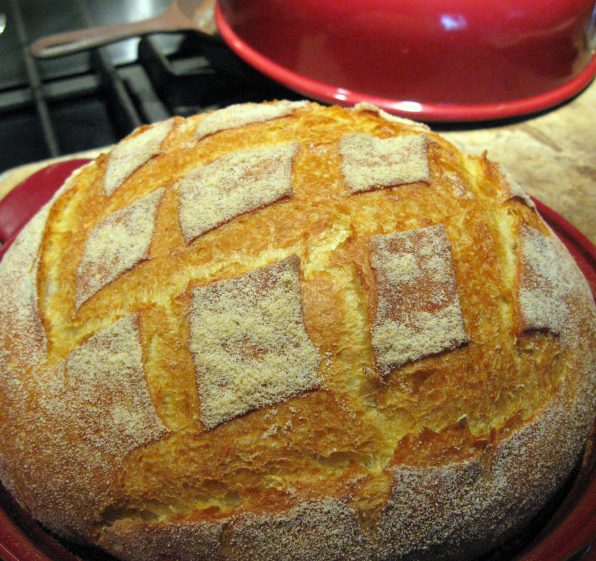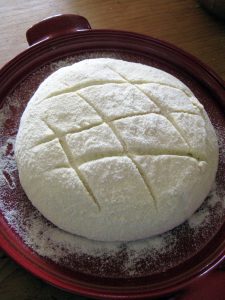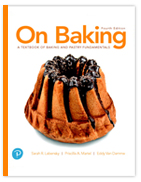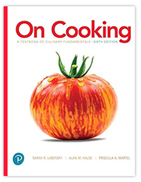There’s a very quick learning curve when baking with the Emile Henry Baking cloche. I have discovered a few tricks to ensure the best results. Here are some of my Tips for Using an Emile Henry Baking Cloche:
• Use the right amount of dough to fill up the cloche without crowding. I bake 2 to 2 ¼-pounds of bread dough in my Emile Henry Baking Cloche. That is a batch of bread dough made from approximately 4 to 5 cups of flour. This amount of dough expands to fill the bread platter and browns beautifully.
• Dust the platter generously with flour, rice flour or rolled oats before baking according to the type of bread you are baking. This ensures your loaf won’t stick.
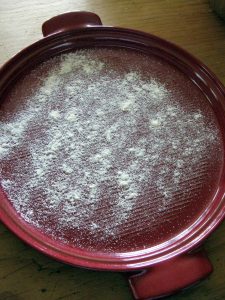
The wetter your dough, the more flour you’ll need to coat the platter. A wet dough will absorb more flour and might still be a little wet. Once you’ve baked with it a few times, you’ll still need flour but the sticking will be less of an issue.
Preheat the cloche or not?
After a bunch of experiments, I’ve decided that this is not necessary. I do however enjoy the results when I bake two or more successive batches of bread in the cloche. I’ll stagger the times when I mix my dough, one batch then a second an hour later than the first. When the first loaf finishes baking, I place the second loaf on the hot platter, cover it with the dome and place it in the oven to bake.
How to shape your loaf before baking in the cloche?
To make plump, round loaves that hold their shape for baking, roll your dough tightly before the final rise. Or place the ball of dough into a bowl lined with a lightly floured cloth towel. French bakers use specially designed cloth lined baskets called bannetons for this purpose. This preserves the shape of the dough. You simply unmold the dough on to the base after it has proofed. (We do not recommend that you bake bread dough that is too soft to hold its shape n a cloche. It made overflow the platter before you get the bell shaped lid in place. If you have a sticky et dough that you normally baked in a loaf pan, don’t try baking it in a Bread Cloche.)
Before baking, adjust your rack so that it is in the bottom third of the oven. You want enough top space for the cloche to fit easily. Then preheat your oven.
When the dough is ready to bake, simply place the cloche and base on the rack.
Because all ovens behave differently, test the temperature the first few times you use the cloche. Set your timer for 10 to 15 minutes less that the time indicated in your recipe. Check your bread by carefully removing the cloche. If you bread is beginning to brown noticeably, you may want to reduce your oven temperature 25°F to 50°F. Conversely, if your loaf seems noticeably soft and pale, increase the oven temperature 25°F to 50°F. Then finish baking.
For a darker and thicker crust, remove the cloche during the last 5 to 10 minutes of baking.
Did you forget to preheat your oven?
Your cloche can be used in a cold oven. Simply place the cloche in the oven, turn on the oven to the desired temperature and bake. Your loaf may be somewhat flatter in appearance but taste just as delicious.
If you would like to bake several batches of bread in your cloche, mix the dough in stages staggered about 45 minutes apart. While one batch of dough is baking, proof the next loaf. You can proof the loaf in a lightly floured cloth-lined bowl or on a parchment-lined baking sheet. Unmold the dough onto the heated platter. Or slide the dough and parchment paper directly onto the base when it becomes available. Trim the paper to fit under the cloche. If the cloche and platter are still warm, your bread will bake more quickly. Just be careful when handing the cloche because it will be very hot.
Kitchen Notebook
I have worked with Emile Henry and the company has given me many pieces of their clay bakeware to test. You can read the detailed Use and Care Guide that I wrote to accompany the Emile Henry Bread Cloche here. I am providing Tips for Using an Emile Henry Baking Cloche because I know how challenging it can be trying a new piece of baking equipment. This is as much for my use as for yours. Hope this helps you enjoy baking yeast bread at home as much as I do.

